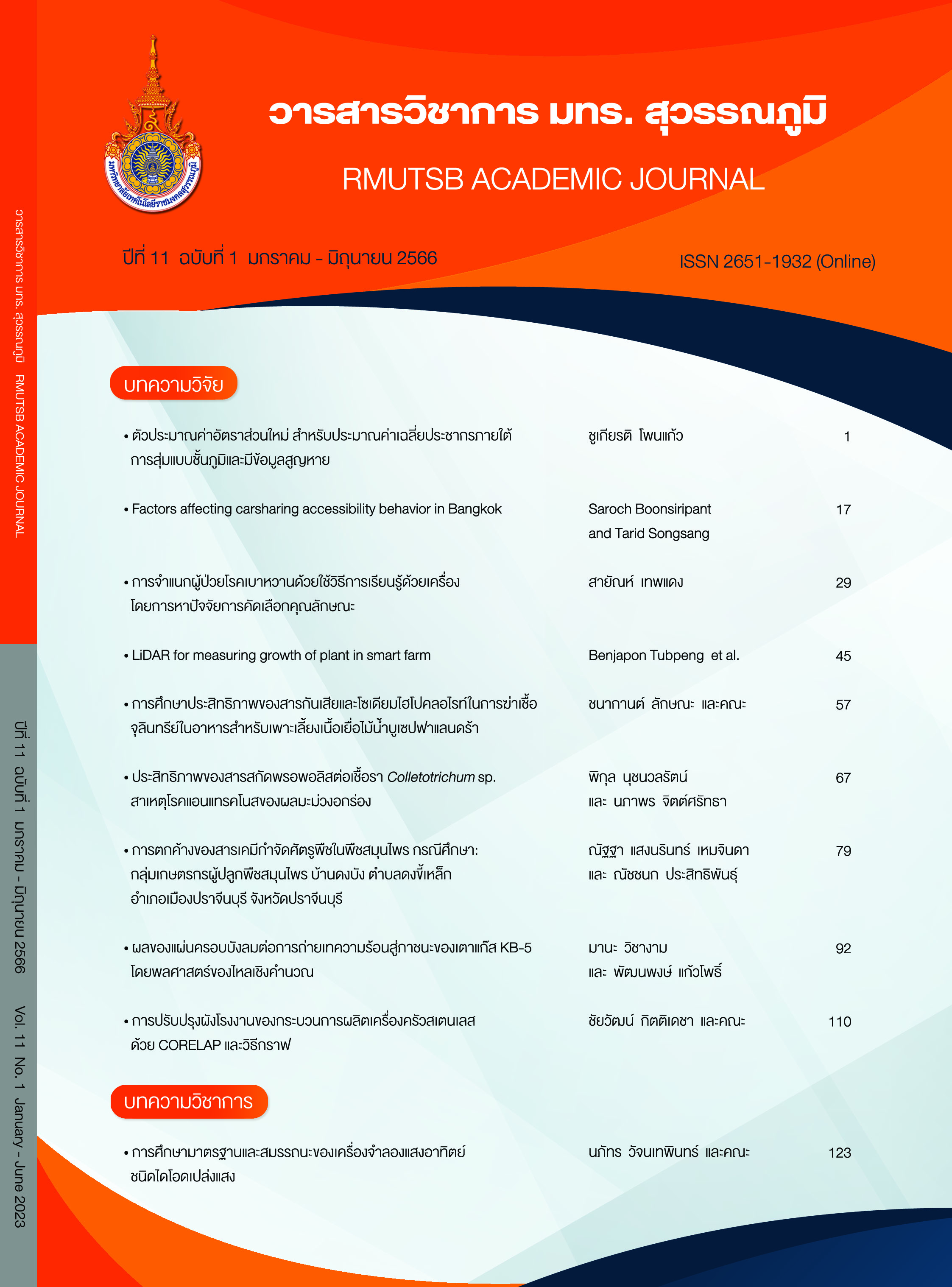Pesticide residues in herbs case study: Bandongbang herbal growers group, Tambon Dongkeerek, Mueang Prachin Buri District, Prachin Buri Province
Main Article Content
Abstract
Pesticide residues in herbs were studied: a case study of Bandongbang Herbal Growers Group, Tambon Dongkeerek, Mueang Prachin Buri District, Prachin Buri Province. This study was conducted using questionnaire and analyzing the residues of herb pesticides by test kits. The results revealed that there was a total of 6 herbal plant growers and 16 species of herbs were planted. Every household has more than 20 years of experience in growing herbs by cultivating their own crops as their main source of income. The herb-growing process did not use chemical pesticides and chemical fertilizers. Ground water was used for irrigation. The most commonly planted herbs were Beijing grass, followed by Thai bitter cucumber and snake plant, respectively. Most of the herbal products were sold to the Chaophraya Abhaibhubejhr Hospital Foundation in the form of dried products. Pesticide residue detection results from 33 samples of 16 types of herbs were analyzed for residues of organophosphate and carbamate pesticides using the GT-Test Kit. Residues at an unsafe level of 1 sample, namely Cocculus, and remaining at a safe level in 3 samples, namely Andrographis herb and Piper sarmentosum. Whereas analyzing the residues of organochlorine and pyrethroid pesticides with the GPO-TM/2 Kit, no residues were found in all samples. Some medicinal plants are characterized by the properties of the psychotropic plan. Therefore, the use of the test kit can only preliminarily detect the residues of herbal pesticides. The detection of pesticide residues should use qualitative and quantitative measuring instruments. In addition, the residues in the environment should be surveyed both on the farmland and nearby areas.
Article Details

This work is licensed under a Creative Commons Attribution-NonCommercial-NoDerivatives 4.0 International License.
Published manuscript are the rights of their original owners and RMUTSB Academic Journal. The manuscript content belongs to the authors' idea, it is not the opinion of the journal's committee and not the responsibility of Rajamangala University of Technology Suvarnabhumi
References
Chaigarun, S., Somboon, S., & Wanchana, S. (2013). Insecticide residues in Isan vegetable and local foods. KKU Journal for Public Health Research, 6(3), 122-129. (in Thai)
Chaopraya Abhaiphubejhr Hospital Foundation. (2018). Foundation “Abhaiphubejhr” bridge of wisdom creating value of Thai medicine. Retrieved 30 May 2022, from https://www.abhaishop.com/th/blog/5734/blog-5734. (in Thai)
Cheewanphisarn, S. (2014). Insecticide residue detection with test kit for vegetable fruits and Cereals. Retrieved 23 April 2022, from https://www.chiangmaihealth.go.th/cmpho_web/document/ 201005160188897021.pptx. (in Thai)
Department of Medical Sciences, Ministry of Public Health. (2009). Thai herbal pharmacopoeia (Vol. III). Bangkok: Office of National Buddishm Press.
Department of Medical Sciences. (2016). Novelty in Thailand for the innovation of insecticide and herbicide test kits. Nonthaburi: Ministry of Public Health. (in Thai)
Department of Thai Traditional and Alternative Medicine. (2016). National master plan on the development of Thai herbs No. 1 2017-2021. Retrieved 18 March 2023, from https://www.opsmoac.go.th/sustainable_agri-knowledge-files-431291791818. (in Thai)
Department of Thai Traditional and Alternative Medicine. (2023). Report on the achievements of the annual government action plan (2022) of Department of Thai Traditional and Alternative Medicine. Retrieved 18 March 2023, from https://www.dtam.moph.go.th/index.php/th/download/9528-dl0141.html. (in Thai)
Hu, X-Y., Wu, R-H., Logue, M., Blondel, C., Lai, L. Y. W., Stuart, B., Flower, A., Fei, Y-T., Moore, M., Shepherd, J., Liu, J-P., & Lewith, G. (2017). Andrographis paniculata (Chuän XÏn LiaÂn) for symptomatic relief of acute respiratory tract infections in adults and children: A systematic review and meta-analysis. PLoS ONE, 12(8), e0181780.
Khawsaard, M., & Leamjareesakul, N. (2014). Thai herbs, Thai traditional medicine in Thai culture. Chiang Mai: Thai Universities for Healthy Public Policies. (in Thai)
Klier, B., Häfner, E., Albert, H., Binder, G., Knödler, M., Kühn, M., Schenk, A., & Steinhoff, B. (2019). Pesticide residues in herbal drugs: evaluation of a database. Journal of Applied Research on Medicinal and Aromatic Plants, 15, 100223.
Lenapun, S. (2014). Contaminants and residues of herbal drugs: Quality control in Thai pharmacopoeia. Journal of Thai Traditional & Alternative Medicine, 12(3), 213-222. (in Thai)
Mukherjee, P. K., Kumar, V., & Houghton, P. J. (2007). Screening of Indian medicinal plants for acetylcholinesterase inhibitory activity. Phytotherapy Research, 21(12), 1142-145.
National Bureau of Agricultural Commodity and Food Standard. (2020). Insecticide residue detection with GT-Test Kit. Retrieved 5 May 2022, from https://warning.acfs.go.th/en/documentary/view/?page=67. (in Thai)
Srithupthai, K. (2018). Detection of pesticide residues in herbal: A case study of farmers group in Ton Phueng sub-district, Phang Khon district, Sakon Nakhon province. Khon Kaen Agriculture Journal, 46(1), 841-846. (in Thai)
Tantiamornkul, K., & Mataradchakul, T. (2019). Detecting insecticide contamination and determining prevalence of protozoa in fresh vegetables from fresh markets, Maung Phayao, Phayao Province. Journal of Public Health 49(1), 118-129. (in Thai)
Vuthijumnonk, J., & Roongruangsri, W. S. (2019). Removal of cyfluthrin by fine bubble technology in oranges (Citrus reticulata Blanco). IOP Conference Series: Earth and Environmental Science, 346(1), 012036.
Wang, Y., Jin, H-Y., Ma, S-C., Lu, J., & Lin, R-C. (2011). Determination of 195 pesticide residues in Chinese herbs by gas chromatography–mass spectrometry using analyte protectants. Journal of Chromatography A, 1218(2), 334-342.
WHO. (2007). Guidelines for assessing quality of herbal medicines with reference to contaminants and residues. Geneva: WHO Press.
Wongprasert, T. (2006). Psychotropic plants. Retrieved 30 October 2022, from https://www.dnp.go.th/botany/PDF/publications/Psychotropic_Plants.pdf. (in Thai)
Wongyai, S. (2019). Development of Thai herbs to the world market Thailand is ready to participate in the competition or not? Retrieved 5 May 2022, from https://www2.rsu.ac.th/sarnrangsit-online-detail/herb01. (in Thai)
Worasuttayangkurna, L., Nakareangritb, W., Kwangjaic, J., Sritangosa, P., Pholphana, N., & Watcharasit, P. (2019). Acute oral toxicity evaluation of Andrographis paniculata-standardized first true leaf ethanolic extract. Toxicology Reports, 6, 426-430.
Zhang, S., Liu, X., Qin, J., Yang, M., Zhao, H., Wang, Y., Guo, W., Ma, Z., & Kong, W. (2017). Rapid gas chromatography with flame photometric detection of multiple organophosphorus pesticides in Salvia miltiorrhizae after ultrasonication assisted one-step extraction. Journal of Chromatography B, 1068-1069, 233-238.


